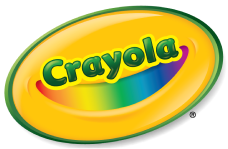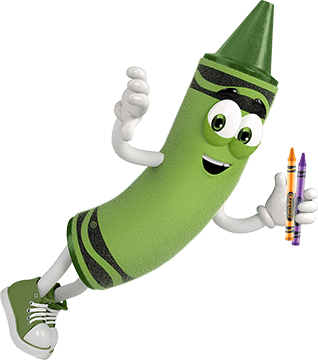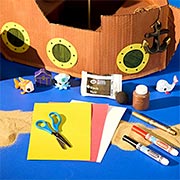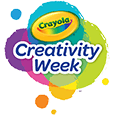La mayoría de nuestros nombres de colores se toman de un libro llamado "Color: Universal Language and Dictionary of Names", que fue publicado por la Oficina de Estándares de EE. UU. Utilizamos esta guía de referencia porque cada persona ve y expresa el color de manera diferente. Usando el diccionario Universal como base, podemos referirnos a un sistema de colores estándar y nombres de colores. Muchos nombres de crayones también se toman prestados de las pinturas de artistas tradicionales. Además, hemos pedido a los consumidores, a través de varias promociones, que ayuden a nombrar los colores de los crayones. Para obtener información sobre futuras oportunidades de nombres de colores, regístrese para recibir nuestro boletín en la página de suscripción al boletín de Crayola.
Si tienes preguntas adicionales, ¡nos encantaría saber de ti! No dudes en llamarnos o enviarnos un mensaje de texto al 1-800-CRAYOLA días laborables entre las 9 AM y las 4 PM hora del Este. Si prefieres enviarnos un correo electrónico, visita nuestra página de contacto.
Preguntas relacionadas
Explora respuestas a preguntas comunes, consejos útiles para eliminar manchas e ideas creativas para aprovechar al máximo nuestros materiales de arte y recursos gratuitos.
-
Throughout Crayola's history, several crayon colors have been retired, marking significant moments in the evolution of our vibrant palette.
1990
For the first time in Crayola history, eight colors were retired and placed in the Crayola Hall of Fame: blue gray, green blue, lemon yellow, maize, orange red, orange yellow, raw umber, and violet blue. Eight new colors were added: cerulean, dandelion, fuchsia, jungle green, royal purple, teal blue, vivid tangerine, and wild strawberry.2003
Celebrating a century of bringing color to the world, Crayola introduced four new colors named by Crayola fans! To make room for the new hues, we bid farewell to blizzard blue, magic mint, mulberry, and teal blue. The four new colors that were introduced are: inchworm, jazzberry jam, mango tango, and wild blue yonder. Kudos to our hue heroes - the consumers who voted in the "Save the Shade" campaign, ensuring burnt sienna stayed in the pack.2017
To mark National Crayon Day on March 31st, we announced Dandelion was leaving the pack. To honor this iconic color, we sent Dandelion on a retirement tour to his favorite places. His replacement, Bluetiful, was announced on May 5, 2017.Looking for more historical facts about our colorful company? We've got them on the Crayola History page!
-
Crayola® Crayons are made using primarily paraffin wax and color pigment. While the basic ingredients remain consistent across all colors, variations may occur in special effects crayons.
Our crayons are crafted through a process that involves melting paraffin wax and blending it with color pigments. This mixture is then poured into molding machines where it solidifies in four to seven minutes. For a behind-the-scenes look at the Crayola crayon manufacturing process, watch the video "You've Got Crayola Crayons" on YouTube.
-
The basic ingredients contained in Crayola® Crayons are paraffin wax and color pigment. These ingredients are the same for all Crayola Crayon colors, with some modifications in special effects crayons.
Crayola Crayons begin to melt at around 105° Fahrenheit and have a melting point between 120° - 147° Fahrenheit. The melting point is the same for all regular Crayola Crayons; however, the density and amount of pigment included in different crayons will result in varying thickness or viscosity of the mixture.
-
Introduced in 1998, Crayola® offers a variety of colored pencil assortments that are the essential creative tool for kids or the art enthusiast. Crayola colored pencils are manufactured in Brazil, Costa Rica or Vietnam due to their high-volume manufacturing capabilities.
The process of making Crayola Colored Pencils begins in the forest. Seedlings, which are young trees, are planted in fields much like a farmer plants a crop. Seedling crops grow into trees which are eventually used to make wood casings for the pencils. After several years, the trees are harvested, cut into even lengths, stacked onto trucks and shipped to the sawmill. Then, a new crop of seedlings is planted to replace those which have been harvested.
At the sawmill, lumber arriving by the truckload is stacked in large piles and allowed to dry. Once dry, the lumber is fed into a bark stripping machine which removes all the bark from each piece of lumber. Next, the lumber goes through a series of milling machines which cuts the lumber into rectangular slats. These slats are about as long as a colored pencil and about three inches wide. The slats are the building blocks for the production of colored pencils.
The slats are then transported to the pencil making plant. Here they are fed into another milling machine which cuts small semicircular grooves at regular intervals down the length of each slat. These grooved slats are now ready to accept a colored pencil core.
To make a Crayola Colored Pencil core, you need four raw materials:
- Extenders - which make up the body of the lead.
- Binders - to hold the ingredients together.
- Pigment - which gives each type of colored pencil its unique color.
- Water – to mix all the ingredients.
First, the extenders, binders, pigments and water are placed in a large mixer which gently kneads them together into a uniform doughy substance. When the mixing is complete, the contents of the mixer are rolled into flat sheets. Finally, these sheets are machine-pressed into large, long solid cylinder shapes. These shapes are called cartridges.
Each cartridge, while still damp and pliable, is inserted into another machine called an extrusion press, where it is forced through a small tube. The tube has a diameter equal to that of a colored pencil core. As the long rope of wet colored core comes out, an automatic slicer cuts it into equal lengths approximately as long as a colored pencil. Since the leads are still quite moist, they must be dried in large ovens before they become hard enough to insert into the slats.
To assemble the pencils, half of the grooved slats are fed into a machine which carefully lays a colored pencil core into each groove. Then a layer of glue is applied, and a second grooved slat is placed on top of the slat holding the lead. Think of this as a pencil sandwich, with each slat acting like a piece of bread and the color cores acting like the filling.
These pencil sandwiches are then bound very tightly together and placed into storage to give the glue time to dry. Once the glue is dry, they are fed into another milling machine which cuts them into individual colored pencils. Depending on the design of colored pencils, they are cut into either round or hexagonal shapes.
Next, the pencils are fed into a machine to be painted with the same color paint as the colored core. The pencils run down a conveyor belt to allow the paint to dry. The painted pencils are then sent to a machine to be automatically sharpened.
Finally, brightly colored finished pencils are packed into boxes, which are shipped to neighborhood stores.
Crayola Colored Pencils are used by people of all ages for everything from crafts to professional artwork and school projects. Learn more about Crayola Colored Pencils products.
-
Crayola® Markers are made with six components consisting of: a color solution, a porous plastic nib, a plastic barrel, a cotton filament (ink reservoir), an end plug, and a cap. Although specific ingredient information is proprietary, most of the color solutions in Crayola Markers are made from water and dyes. Below is the process we follow to make Crayola Markers.
- Tiny beads of plastic are fed into a molding machine where they are melted and then molded into marker barrels. The liquid plastic becomes solid, white marker barrels in a matter of seconds.
- Any extra plastic from the molding process goes back into the molding machine to make new marker barrels.
- The marker barrels are screen printed with the Crayola brand name and most with the color name of the marker. The process is like screen printing t-shirts, where the ink colors pass through a pre-made screen onto the printing surface. Up to 6 distinct colors can be used to decorate the marker barrel at one time! The ink dries quickly as the marker barrel passes through a drying tunnel.
- The assembly machine lines up the marker barrels in the same direction as they move along a conveyor belt. The end plug and ink reservoir are inserted into the marker barrel, and the color solution is injected into the soft reservoir. The marker nib, or drawing tip, is added to the open end of the marker, followed by the cap. It takes a minute or two for the ink to travel up from the reservoir to color the nib, so the marker is ready to write!
- The finished markers are placed in a sorter - a machine with separate sections for the assorted colors. A chute drops one marker of each color onto a conveyor belt, creating the colorful assortment that will fill the marker box.
- A robotic arm opens the flat marker boxes and sends them down the conveyor belt. Another robotic arm pushes the markers into the boxes and closes them. After the assembled markers are packed in large cartons, they are ready to be shipped to stores.
Did you know....
Crayola makes more than 700 million markers a year!
- The first box of Crayola Markers was introduced in 1978 and included 8 bright colors.
- In 2014, Crayola introduced Ultra-Clean Washable Markers. They clean up easily from skin, clothing, and painted walls.
- Crayola Broad Line Markers are tested to write a minimum of 300 feet - almost the length of a football field!
- Crayola Fine Line and Super Tips Markers are tested to write a minimum of 600 feet.
Learn more about Crayola Markers on the Crayola Markers Page.




